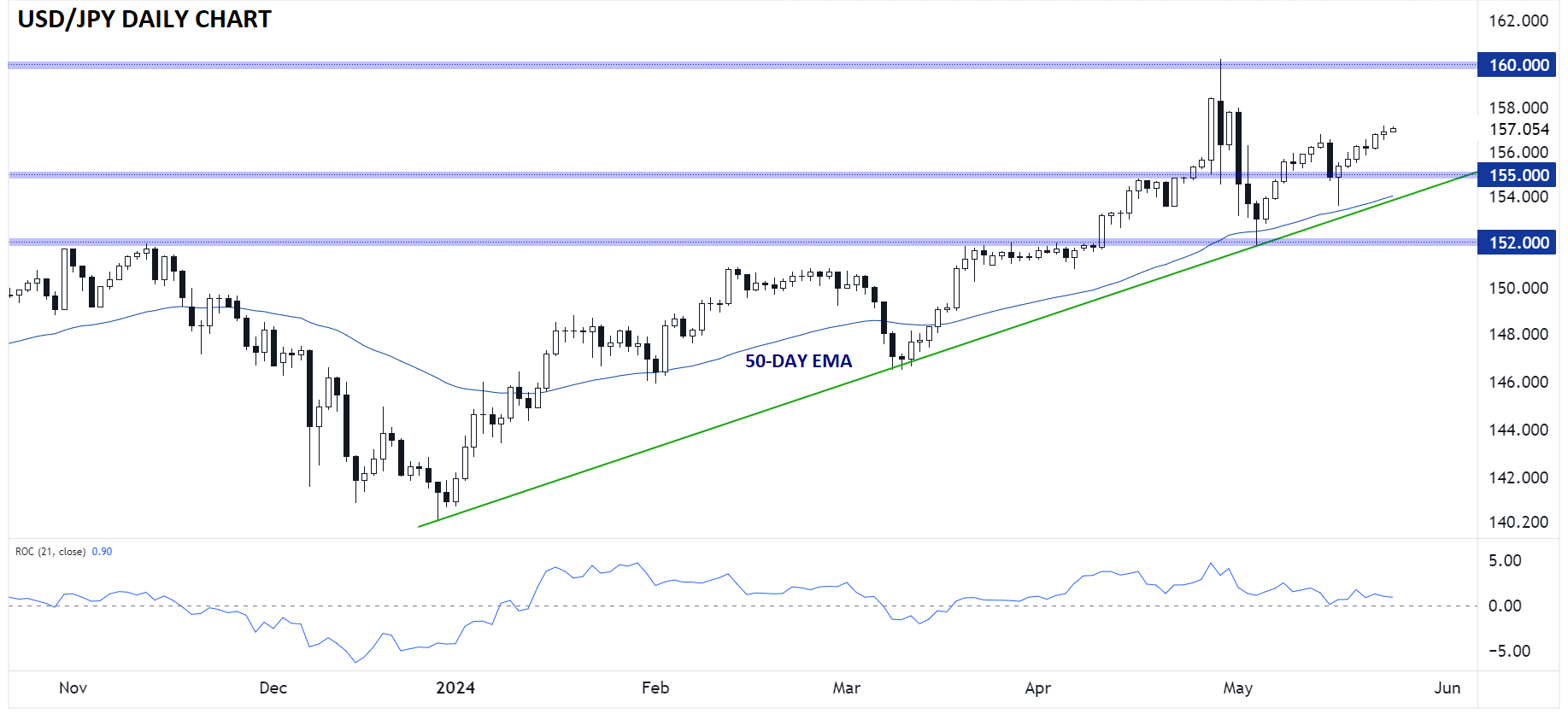
USD/JPY Key Points
- While the yen is approaching its lows from late April, the BOJ is less likely to intervene this time around given the relative ineffectiveness of the last round of intervention and international warnings against further intervention.
- The gradual, controlled nature of the yen’s depreciation also makes intervention less likely.
- USD/JPY remains in a bullish technical posture, with potential for a retest of 160.00 unless the BOJ changes course no interest rates.
If you rewound the clock by a month, you’d undoubtedly be reading constantly about the risk of Japan’s Ministry of Finance (MOF) and the Bank of Japan (BOJ) intervening into the forex market to support the value of the yen (suppress XXX/JPY pairs). As we all know by now, that direct intervention did indeed occur, once at the end of April when the yen selling became acute, and again in early May when Japanese policymakers sensed weakness in the US dollar following a softer-than-expected US CPI report.
Though the (lack of) headlines seem to suggest that traders have moved on to other concerns, the yen has quietly resumed its drop over the last three weeks, taking USD/JPY back to 157.00 for the third highest daily close in the last 30+ years. The yen weakness is even more apparent in some of the yen crosses, with EUR/JPY closing at a 20+ year high above 170 and GBP/JPY hitting a 16-year high at 200.00 in Friday’s trade. Put differently, relative weakness in the US dollar over the last month is masking the broad-based yen weakness against Japan’s non-US trading partners.
From the perspective of Japanese policymakers, it’s far more difficult to make a case for intervening in the forex market for at least three reasons:
First, the last intervention in late April/early May didn’t “work”; the yen is back near the same level a few weeks later, suggesting that the $5T/day forex market was willing to sell the BOJ-driven bounce in the yen and would likely do so again.
Secondly, global policymakers have pushed back against Japan’s recent intervention, wary that it could spark competitive devaluations in other currencies. On Thursday, US Treasury Secretary Janet Yellen announced that, “[w]e believe intervention should be rare, when it occurs it should be communicated in advance, and if it occurs it should largely be in response to volatility in currency markets. Intervention is not a tool that we think should be used in any routine way at all.” Intervening again, against the wishes of some of the world’s most important policymakers, would risk the ire of key trading partners like the US.
Thirdly, we aren’t seeing the trading conditions that would justify another round of intervention. Currency weakness alone is not seen as enough to justify intervention; instead central banks, including the BOJ, explicitly look for “one-way”, “disorderly” trade. The price action in late April arguably reached that threshold, with USD/JPY surging nearly 5% in a month. In contrast, the 1-month rate of change in USD/JPY currently is closer to 1%, a relatively unremarkable move for a major currency pair. The gradual nature of the yen’s depreciation over the last few weeks makes it far more difficult for the MOF and BOJ to justify intervening again.
Ultimately, it feels like the only thing that will stop the yen’s depreciation is a shift in the Bank of Japan’s monetary policy. Until the central bank credibly signals that it “normalize” its still-0% interest rate, the yen is likely to remain under pressure.
Japanese Yen Technical Analysis – USD/JPY Daily Chart

Source: TradingView, StoneX
As the daily chart below shows, USD/JPY has been grinding consistently higher for more than three weeks since the Bank of Japan last intervened to drive the pair lower at the start of the month. From a purely technical perspective, the year-to-date uptrend remains intact, with support consistently emerging at the rising bullish trend line (green) and 50-day EMA (blue).
As long as prices remain above those dynamic support levels, traders will favor buying dips in the pair, and the path of least resistance will remain to the topside for a potential/eventual rest of the key 160.00 level that finally pushed the BOJ to act in late April.
-- Written by Matt Weller, Global Head of Research
Check out Matt’s Daily Market Update videos on YouTube and be sure to follow Matt on Twitter: @MWellerFX






